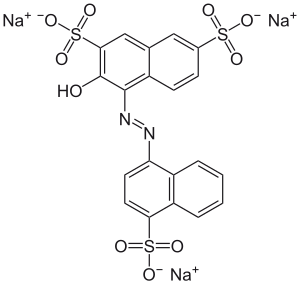Amaranth (dye)
| Structural formula | |||||||||||||||||||
|---|---|---|---|---|---|---|---|---|---|---|---|---|---|---|---|---|---|---|---|

|
|||||||||||||||||||
| General | |||||||||||||||||||
| Surname | Amaranth | ||||||||||||||||||
| other names | |||||||||||||||||||
| Molecular formula | C 20 H 11 N 2 Na 3 O 10 S 3 | ||||||||||||||||||
| Brief description |
dark red-brown powder |
||||||||||||||||||
| External identifiers / databases | |||||||||||||||||||
|
|||||||||||||||||||
| properties | |||||||||||||||||||
| Molar mass | 604.46 g mol −1 | ||||||||||||||||||
| Physical state |
firmly |
||||||||||||||||||
| solubility |
soluble in water: 50 g l −1 (20 ° C) |
||||||||||||||||||
| safety instructions | |||||||||||||||||||
|
|||||||||||||||||||
| Toxicological data | |||||||||||||||||||
| As far as possible and customary, SI units are used. Unless otherwise noted, the data given apply to standard conditions . | |||||||||||||||||||
Color amaranth
color code: # E52B50
color code: # E52B50
Amaranth is a red, water-soluble azo dye that is used as a food coloring . In Europe it is approved as a food additive E 123.
Amaranth is resistant to light, heat and the preservative benzoic acid . Amaranth loses its color in the presence of fruit acids . Amaranth is used for aperitif wines, spirits and fish roe .
In the United States and the former Soviet Union, amaranth is not approved as a food additive. It is believed that amaranth can trigger pseudoallergies , skin reactions and bronchial asthma . The International Agency for Research on Cancer (IARC) lists amaranth in Group 3: not classified .
See also
Individual evidence
- ↑ Entry on E 123: Amaranth in the European database for food additives, accessed on June 16, 2020.
- ↑ Entry on CI 16185 in the CosIng database of the EU Commission, accessed on June 16, 2020.
- ↑ a b Amaranth data sheet (dye) from Acros, accessed on February 20, 2010.
- ↑ a b c Amaranth data sheet at Sigma-Aldrich , accessed on March 20, 2011 ( PDF ).
- ↑ ZZulV: Annex 1 (to Section 3, Paragraph 1 and Section 7) Additives that are approved for coloring food or for achieving color effects on food
- ↑ Compliance Program Guidance Manual - Foodborne Biological Hazards p. 37 (PDF; 336 kB) of the FDA
- ↑ monograph IARC , IARC Monographs on the Evaluation of Carcinogenic Risk of Chemicals to Man. Volume 8. Some Aromatic Azo Compounds. (PDF, 16.5 MB) , accessed on February 12, 2018.
Web links
Commons : Amaranth (dye) - Collection of images, videos and audio files
